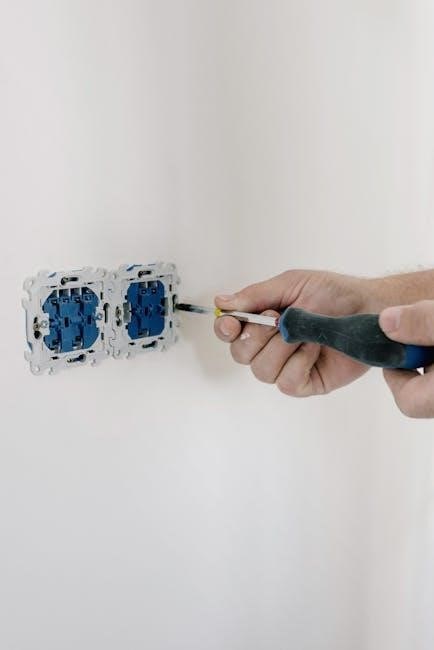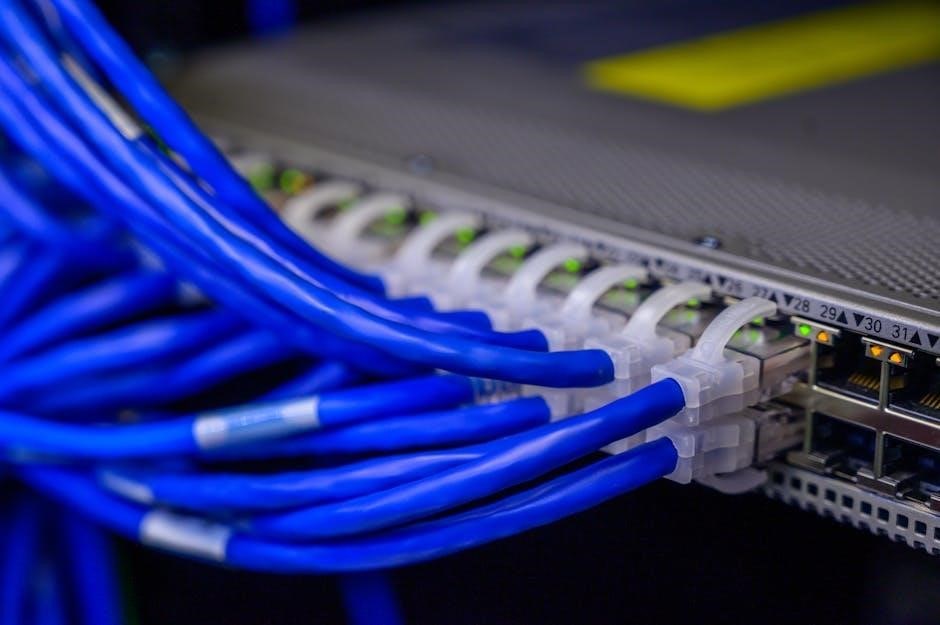The transfer switch wiring diagram manual provides essential guidelines for installing and testing transfer switches, including mounting and connecting procedures, using
- step-by-step instructions
and diagrams.
Purpose and Importance of Transfer Switches
The purpose of transfer switches is to prevent electrical feedback between different power sources, such as utility and generator sources, and to ensure a safe and reliable transfer of power.
The importance of transfer switches lies in their ability to automatically transfer electrical loads from a utility power source to a generator power source when the utility power source fails or is substantially reduced.
This is crucial for maintaining power supply to critical systems and equipment, and for preventing damage to electrical systems and equipment.
Transfer switches play a vital role in ensuring the continuity of power supply, and their proper installation and maintenance are essential for ensuring their effectiveness.
The use of transfer switches is mandated by codes in all standby electric system installations, and their importance cannot be overstated.
They are an essential component of any electrical system that requires a reliable and safe transfer of power.
Transfer switches are used in a variety of applications, including residential, commercial, and industrial settings.
Components of a Transfer Switch
The components of a transfer switch include a transfer mechanism, a control relay, a terminal strip, and a fuse holder for connection.
These components work together to provide a safe and reliable transfer of power between different power sources;
The transfer mechanism is responsible for switching between the different power sources, while the control relay provides the necessary control signals.
The terminal strip provides a convenient means of connecting the transfer switch to the electrical system, and the fuse holder provides protection against overcurrent conditions.
The components of a transfer switch are designed to work together seamlessly to provide a reliable and efficient transfer of power.
The transfer switch also includes auxiliary contacts that can be used to provide additional control functions.
The components of a transfer switch are typically mounted in a enclosure that provides protection against environmental factors.
The enclosure is designed to be durable and reliable, and to provide easy access to the components for maintenance and repair.
The components of a transfer switch are critical to its operation and must be properly installed and maintained.

Installation Procedures for Transfer Switches
Transfer switch installation involves several key
- steps
and considerations to ensure safe operation.
Mounting the Enclosure
To ensure proper installation, mounting the enclosure is a crucial step, requiring careful attention to detail and adherence to manufacturer specifications, as outlined in the transfer switch wiring diagram manual. The enclosure should be mounted in a location that provides easy access for maintenance and testing, using suitable hardware and following the recommended torque requirements. It is essential to consult the manual for specific mounting dimensions and procedures to avoid any potential issues or damage to the transfer switch. By following the guidelines and taking necessary precautions, a safe and reliable installation can be achieved, providing peace of mind and ensuring the transfer switch functions correctly when needed. The transfer switch wiring diagram manual provides a comprehensive guide for mounting the enclosure, including diagrams and illustrations to facilitate the process, making it easier to understand and complete the installation successfully.
Connecting Power Source and Load Leads
Connecting the power source and load leads is a critical step in the installation process, requiring careful attention to detail and adherence to safety protocols, as outlined in the transfer switch wiring diagram manual. The manual provides a detailed guide for connecting the power source and load leads, including diagrams and illustrations to facilitate the process. It is essential to ensure that all connections are secure and meet the recommended torque requirements to prevent any potential issues or damage to the transfer switch. The transfer switch wiring diagram manual also provides information on cable sizes and field connections, making it easier to understand and complete the installation successfully. By following the guidelines and taking necessary precautions, a safe and reliable connection can be achieved, providing peace of mind and ensuring the transfer switch functions correctly when needed, with a focus on safety and efficiency.

Testing and Maintenance of Transfer Switches
Regular testing and maintenance of transfer switches ensure reliable operation, using
- specific procedures
outlined in the manual.
Transfer Test
The transfer test is a crucial step in ensuring the proper functioning of the transfer switch, and it is typically performed after installation and maintenance. The test involves simulating a power outage to verify that the transfer switch can seamlessly transfer power from the utility source to the generator source. This test can be done manually or automatically, depending on the type of transfer switch being used. The manual provides a detailed procedure for conducting the transfer test, including the necessary precautions and safety measures to take. By following the steps outlined in the manual, users can ensure that their transfer switch is working correctly and provide a reliable source of power during outages. The transfer test is an essential part of the maintenance routine, and it should be performed regularly to guarantee the continued operation of the transfer switch.
Wiring Diagrams and Manual Transfer Switch Standard Specs
The wiring diagrams and manual transfer switch standard specs are essential components of the transfer switch wiring diagram manual. These diagrams provide a detailed illustration of the transfer switch’s electrical connections, including the terminal strip and fuse holder. The manual transfer switch standard specs outline the requirements for the transfer switch, including the scope, general requirements, and installation procedures. The specs are typically provided in a PDF or DOC format, making it easy to access and reference. The wiring diagrams are used to connect the power source and load leads, as well as the generator start and sensing circuit. By following the standard specs and wiring diagrams, users can ensure that their transfer switch is installed and functioning correctly. The specs and diagrams are regularly updated, with the latest revision dated 02/13/2020, to reflect changes in industry standards and best practices.

Automatic Transfer Switches
Automatic transfer switches provide reliable and efficient transfer of electrical loads between power sources using advanced technology and
- programming
methods easily.
Functionality and Application
The functionality of automatic transfer switches is to provide a seamless transfer of electrical loads between different power sources, ensuring continuous power supply to critical systems. This is achieved through advanced technology and programming methods. The application of automatic transfer switches is widespread, ranging from residential to industrial and commercial settings. They are used in data centers, hospitals, and other facilities where uninterrupted power supply is essential. The switches are designed to monitor the power sources and automatically switch to the backup source in case of a power failure or disturbance. This ensures that the electrical loads are transferred safely and efficiently, minimizing downtime and damage to equipment. The switches are also equipped with features such as overload protection, short circuit protection, and ground fault protection, making them a reliable and efficient solution for power transfer applications.

Transfer of Electrical Loads
The transfer of electrical loads is a critical function of automatic transfer switches, allowing for the safe and efficient transfer of power between different sources. This process is typically initiated when the primary power source fails or is substantially reduced, and the backup source is available and within acceptable parameters. The transfer switch then connects the electrical loads to the backup source, ensuring continuous power supply. The transfer process is typically automatic, but can also be manual, depending on the specific application and requirements. The transfer switch is designed to handle the transfer of electrical loads quickly and efficiently, minimizing downtime and damage to equipment. The switch is also equipped with features such as sensing and control circuits, which monitor the power sources and initiate the transfer process when necessary. This ensures a smooth and reliable transfer of electrical loads, making it an essential component of any power distribution system.
